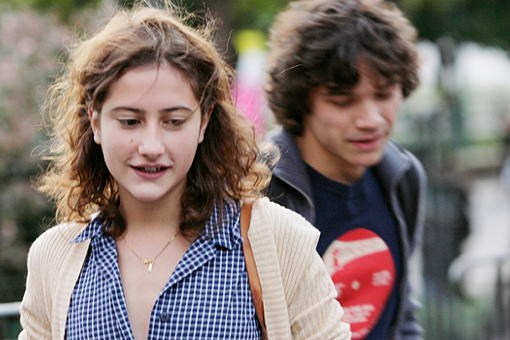By Pam Glazier · April 23, 2012

Goodbye First Love is a French film that follows young Camille (Lola Créton) through life as she experiences the wide array of emotions that go along with first love. When the film begins, Camille is 15 and her boyfriend Sullivan (Sebastian Urzendowsky) is perhaps two to three years older. Despite the deep love that exists between Camille and he, Sullivan has a wanderlust that cannot be quenched. He quits school and vows to travel the world. Camille is devastated but he swears that the trip will only be for ten months and that he’ll be back before she knows it.
As life goes on Camille waits longingly for letters from him, and she keeps a map with location pins to mark his progress. Eventually he stops writing, but despite this Camille still remains faithful. But after several angst-filled years, as she finishes school, goes to college, etc. Camille stops waiting. She meets a nice architect named Lorenz (Magne-Havard Brekke) and begins a serious relationship with him. After a while, Sullivan reenters the picture and Camille must choose whether she will forsake the happy love she found for the tumultuous stormy love that she can have again with Sullivan.
While the plot seems simple enough, this film is not about the ins and outs of these relationships. What it is actually doing is covering the underlying feelings, the small observations that happen in routine life that speak deeply to the longstanding emotional traumas that we all must carry along with us on our backs.
The dialog in this film is sparse, because it had to be. The subject matter, the theme, all of it is love and loss and difficult choices—the kind that can’t be expressed rightly in words. And it is so much more interesting to see a silent romance filled with choices as opposed to a wordy romance without any movement.
I did notice that there were two lengthy, music-filled montages in this piece—and of course, we all know that multiple musicy montages are the devils work—but here they seemed to fit somehow. I think that this is because the director, Mia Hansen-Løve, envisioned, and then wrote, and then filmed this movie as if it was a poem or a song. All throughout there seems to be a sense of capturing the stillness and the gravity of a moment, even in scenes where these qualities would not be assumed to be the go-to themes. The cinematography, the way the light plays on things, all of it was planned. And it’s interesting that these elements capture those emotions that cannot be captured by words: the sense of complacency one gets when simply quietly being with a lover; the wrenching pain of everyday life from a two-word rejection. It is in this way that the repeated montage evades being a trite escape from writing and becomes instead a repetition on a theme, echoing back to the feelings that the first one evoked.
Thus one of the things that can be learned from this film as regards to screenwriting is that description is just as important as dialog, and if every little thing within both of them points to something ethereal, then you can transcend the two and reach an intangible. The film even hints at this idea when, during a class evaluation, one of Camille’s architecture instructors explains why she must pay attention to every nuanced detail in her building design in order to evoke this very same thing within the design of spaces.
I hate to sound so pompously enthusiastic about this movie, but the director really did make a gem of a film. All of its elements come together to make something that would have been impossible otherwise.
But, that being said, if you don’t like weird Frenchy movies that highlight the ennui of life and leave you feeling silently introspective and baffled at the more nuanced aspects of human emotion, then you probably won’t like this film. I, on the other hand, felt the calm depth of emotional latitudes that it reached and spent a couple hours writing poetry after watching it.